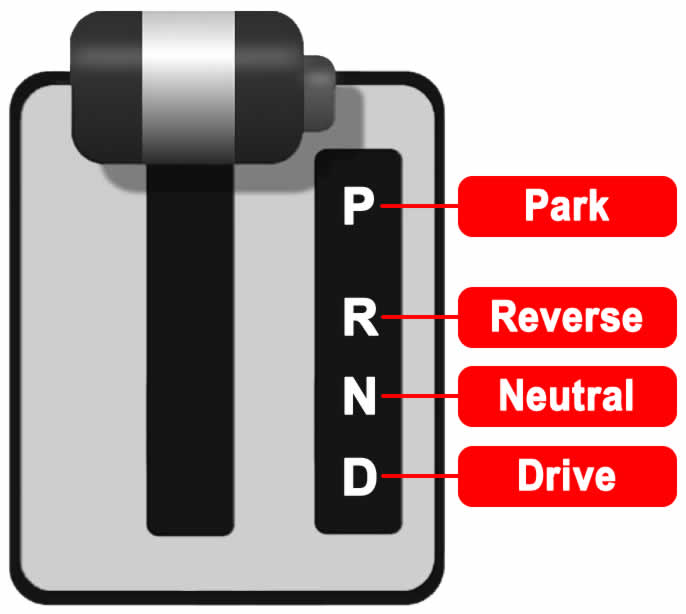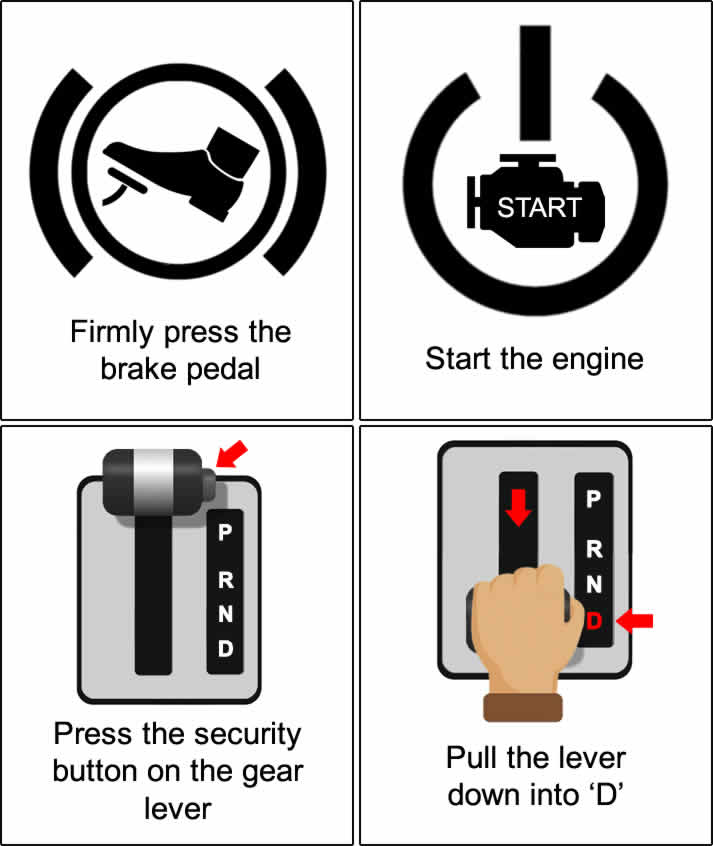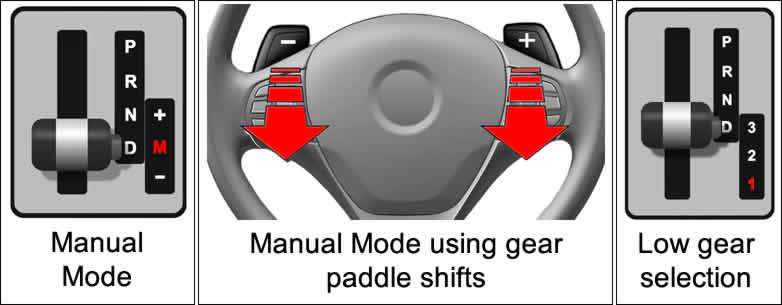This tutorial is for those that have a full driving licence, have only ever driven a manual and need a easy, step-by-step guide on how to drive an automatic car for the first time. This will be a simple tutorial to follow, with diagrams and is essentially: how to drive an automatic car for dummies.
Automatic Gear Shift Letters Meaning
Before driving an automatic car, you’ll need to know what the letters mean alongside the gear shift.

Most gear shift letters are the standard PRND and should be used as follows:
Park
When selecting ‘P’, or Park, the automatic gearbox is locked. This provides and extra layer of security in preventing the vehicle from rolling. When you’ve parked the vehicle, always leave the transmission in the Park position and apply the parking brake / handbrake. The Park function may either be located at the top of the gear selections, or a Park button may be located on the shifting lever. Look out for a button with ‘P’ on it.
Important: Shifting into P (Park) while the vehicle is in motion will cause the drive wheels to lock which will cause you to lose control of the vehicle. The vehicle’s transmission may also be damaged. Always wait until the vehicle is at a complete standstill before shifting into Park.
Reverse
When selecting ‘R’, the car will go into reverse gear. The car will reverse at a similar speed as a manual car in reverse.
Important: Always come to a complete stop before shifting into or out of R (Reverse). The vehicle’s transmission may be damaged if you shift into Reverse while the vehicle is in motion.
Neutral
You’re unlikely to need to use neutral. Neutral in an automatic car is the same as it is in a manual car in that no gears are engaged. Unlike Park, the gearbox is not locked, so neutral should be selected if the vehicle is to be towed or pushed for any reason.
Important: Do not drive with the shift lever in N (Neutral). Engine braking along with traditional braking helps the vehicle to slow down or stop. By driving with the shift lever in Neutral, the engine brake will not work and may lead to an accident.
Drive
By selecting ‘D’, or Drive, the gearbox will automatically select the appropriate gear without any need for driver input.
Which Feet to Use in an Automatic Car
As a driver of a manual car, you’ll be used to using both feet and that needs to change when driving an automatic. It’s important that you only use your right foot to operate both the brake or accelerator when driving an automatic car. You never need to brake or accelerate at the same time.
You may consider that using your left foot to operate the brake and your right foot to operate the accelerator sounds ideal, but as a driver of manual cars, you may forget the left pedal is the brake and depress it as you do the clutch.
How to Start an Automatic Car
Starting and getting the car ready to drive and moving off is much easier in an automatic than a manual car.

- Before starting the engine, firmly press the brake pedal using your right foot.
- Start the engine.
- Press the security release button on the gear selector lever.
- Pull down the gear selector lever into the ‘D’ (Drive) position.
For many automatic cars, it’s a requirement for the brake pedal to be pressed before starting the engine. The engine will often be immobilized until the brake pedal is pressed. This is a safety feature to ensure the car doesn’t move when the engine’s started.
The security button on the gear selector lever is a safety mechanism to prevent accidental gear changes, particularly reverse gear. These buttons are associated with a linear gear shift that operates up and down in a straight line as in the diagrams. The button is located in different places on the lever depending on the car. If you have a gated gear shift pattern: ![]() there’s no need to have a security button.
there’s no need to have a security button.
Manually Changing Gears
For the majority of drivers of automatic cars, allowing the automatic transmission to choose the appropriate gear is sufficient. A transmission that allows you the option of fully automatic and the ability to change gear is called a semi-automatic transmission. The reasons a driver may want to manually change gears is:
- Because they want more control over the vehicle
- To change to a lower gear due to towing a heavy load
- To change to a lower gear for greater power for ascending a steep hill
- To change to a lower gear to make use of engine braking when descending a steep slope
A semi-automatic transmission often has 6 or more gears and vehicle’s current gear will be displayed on the dashboard. How you change gears manually in an automatic car varies from car-to-car. Here we’ll explain the most common way of changing gears manually and when to do it.

Manual Mode
For changing gears, most modern automatic transmissions now have a manual mode. If you can see the letter ‘M’, that stands for Manual mode. From Drive, simply switch the gear lever over to Manual mode (this can be done either from stationary or while moving) and you’ll be able to change up and down gears. Pull the lever down to the ‘-‘ symbol to change down a gear and push it up to the ‘+’ symbol to change up a gear.
Gear Paddle Shifts
Instead of the gear up and down selector being on the gear lever, many automatic cars now come with gear paddle shifts. These are located at the steering wheel and operate in the same way as the gear up and gear down shifts at the lever. Located somewhere around the lever will be an option to select ‘M’ and may be in the form of a button.
Low Gear Selection
Some automatic cars provide the driver with the ability to change down gears. The options vary depending on the car, so we’ll explain the possible variations.
Gear 1, L or D1
The number ‘1’ on an automatic gear stands for 1st gear. If you have the letter ‘L’, this stands for Low gear and is actually 1st gear. On some automatics, this gear may be labelled as D1. They’re essentially all the same thing. When selected, some automatics will lock 1st or Low gear in, while others will change up to 2nd gear if the engine’s revolutions get too high.
When to use: You would use 1st gear or low gear if descending a steep slope as this would make use of engine braking and reduce the risk of the brakes overheating. You can also select 1st or Low gear when ascending a steep slope as this will maintain engine power to help climb the hill.
Gear 2 or D2
Number 2 on the automatic gear selector is 2nd gear. When selected, some automatics will use 1st and 2nd gears only, while others will start and remain in 2nd gear only.
When to use: Low gears are all about maintaining engine power, otherwise known as ‘torque’. Use gear 2 to ascend hills and to make use of engine braking while going downhill. Gear 2 can also be used if your car is stuck in snow. Some automatics may have ‘Snow Mode’ which is essentially the car starting off in 2nd gear.
Gear 3 or D3
Number 3 on the automatic gear selector is 3rd gear and on some automatics, it may be seen as D3. Again, depending on the car, the transmission may use from 1st up to 3rd gear, or lock in 3rd gear only.
When to use: 3rd gear is ideal when you need more engine power at higher speeds. For example, if you’re towing a load and are struggling with engine power due to the transmission automatically changing up gear, change to 3 as this allows the engine to be pushed harder before it changes up.
Slow Down Before Changing Down
If you’re driving a manual car at 60 mph in 5th gear, you wouldn’t change down directly into 1st without first slowing down. If you did, you’d likely cause a lot of damage. The same applies to automatic cars. Ensure you’re at a safe speed for a low gear or slow the car down to an appropriate speed before changing.
Kick Down
Another way of changing down gear in an automatic car is to use kick down. This is a procedure that simply requires the driver to ‘floor’ the accelerator pedal and by doing so, the automatic transmission will change down to a lower gear.
Use kick down just before carrying out an overtaking manoeuvre for greater acceleration, or if your car is struggling to drive up an incline and the transmission hasn’t automatically changed down, kick down will make it change down a gear.
Creeping
A very useful addition to automatic cars is the ability to creep. What this means is that when a forward or reverse gear is selected and the brakes are released, the car will creep forwards or backwards at a slow speed. This is usually at about a walking pace.
The benefits of creep going forward is if you’re in a slow moving traffic queue, you’ll often only need to operate the brake pedal to control your speed. This is far easier than the constant operation of the clutch and gas pedal in a manual car. It also makes slow manoeuvres much easier such as parking as you only need to use the brake pedal to control your speed.
Basic Principles of Operation
There we have it, that’s the basics on how to drive an automatic car. But, while all automatic cars have the same basic principles of operation as outlined in this tutorial, automatic and semi-automatic vehicles can differ from car-to-car. If you’ve purchased an automatic car for the first time, it’s usually a good idea to read the owners manual, or if you’re borrowing or hiring a car, ask the vehicle owners about operation of the automatic transmission.
I recently purchased Maruthi Suziki Celario ZXI Ags model with power steering.Iam finding it hard to turn the steering either to right or left in U turns. Iam told that steering becomes free after running about 1000 kms.Can you suggest remedy?Regards
Hi,
If the car has been sitting for a while, the steering might be a little stiff due to the joints not working in a while. But after a few turns, it should be operating as expected. For steering to become ‘free’ after 1000 km is nonsense. There is something wrong with the power steering system of your vehicle. Did the vehicle come with a warranty?
We are buying an automatic Dacia Duster and keep searching for any infos regarding this topic, so thank you so much for sharing.
You’re welcome, V.C.
I guess the handbrake should be released after selecting D before excellerating
Hi William,
Yes, that’s correct. The only circumstance where you might want to gently apply the accelerator before releasing the handbrake is if you’re on a slope and are at risk of rolling backwards. On a steep slope, the vehicle’s creep function may not be enough to prevent rolling. That’s assuming that the vehicle does not have hill start assist.